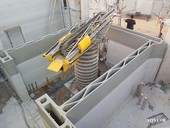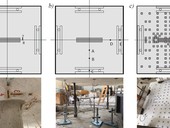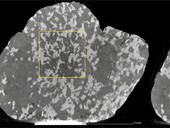The paper presents the outputs of a computational parametric study investigating the influence of both reinforcement ratio and scheme of a cross-section reinforcement on a design value of the elastic module for the homogenized cross-section and the values of the stress redistribution coefficients. The design value of the elastic module represents the steel-concrete cross section in the calculations. The stress redistribution coefficients converts the state stress in the homogenized cross-section for the state stress in steel and concrete individually. The design value of the homogenized cross-section elastic module and the stress redistribution coefficients are determined from the theory of the cooperating rings and are computed by program HOMO. The result of a study is a set of the stress redistribution coefficients and a dependency of stress redistribution coefficients on the reinforcement ratio of a steel-concrete section.
Archiv článků od 19.4.2021 do 13.9.2021
The paper exposes knowledge referring a correspondence of stress states in the cross-section of steel concrete lining. The two different theories size the stress states. The first a theory of cooperating rings is pursued at department of geotechnics. The second referential is a reinforced concrete theory in use at building construction habitually. The correspondence targets the evaluation of suitability and the working condition of a cooperating rings theory to state the stress in the cross-section of steel concrete lining. An investigation was work out on a steel concrete section having been endorsing by lattice girder.
3D printing technology has contribution in building automatization. Today, printed buildings for everyday usage already exist. 3D printers movements are controlled by G-code. These buildings are described geometrically and then it's transformed in G-code by postprocessor. That one for building printing must respect the properties of printing mixtures. This work designs new postprocessor for building printing. It must include mathematical model of material according to which G-code for specific building geometry will be generated. In the work are proposed experiments to find out parameters for mathematical material model.
Fibre reinforcing of the soils is one of the methods used for improving the properties of the soils. The many research papers were interested in the fibre reinforcing however, used fibres were straight with smooth surface usually. These properties may not ensure sufficient interaction between soil aggregates and fibres. This disadvantage could eliminate by modification of shape or surface of each fibre and achieve a higher strength of the soil-fibre composite. In this paper is present the soil reinforcing by fibres manufactured by 3D printer. The fibres with the various shapes were made and tested. In the case of the modified fibres, the higher peak strength of the composite occurred.
This article examines the process for the synthesis of forsterite–spinel refractory ceramics from different raw materials. Raw materials were milled, mixed in different ratios and sintered at 1500 °C for 2 h. Sintered samples were characterized by XRD and SEM. Porosity, water absorption, bulk density, refractoriness, refractoriness under load and thermal shock resistance were also investigated. The impact of different raw material mixtures was investigated in accordance with the resulting properties and microstructure of all fired samples. Presence of spinel in fired samples led to improved microstructural and mechanical properties and thermal shock resistance. In particular, mixtures with 10–20 % of spinel had the most promising results.
This paper deals with experimental verification of punching shear resistance of a slab fragment. An experimental specimen with thickness of 0.2 m is supported by a rectangular column with cross-sectional dimensions of 0.15 × 0.9 m, as a result of which the shear stress is concentrated in the area of the support corners. As a result of this phenomenon, it is necessary to reduce the length of the control perimeter. Based on the results obtained from the experimental test and from the nonlinear analysis in the Atena program, the real necessity to reduce the length of the control perimeter was analyzed using the Eurocode 2 shear resistance evaluation formula. Subsequently, the reliability of selected design models was verified.
The method of X-ray micro-tomography is increasingly used in the research of material characteristics and fracture behavior of building materials. It brings promising results in the field of three-dimensional observation and quantification of microstructure elements, including fracture objects. However, with the standard approach to the tomographic data acquisition, the achievable resolution is severely limited by the size of the examined object resulting in a reduction or even complete loss of useful information regarding, for example, the shape and size of the fracture process zone. For this reason, the possibilities of tomographic targetting of the region of interest with a higher achievable resolution than the usual limit of the tomographic systems have been tested in this work.
This work deals with research and development of a new grouting mortar with increased chemical resistance based on portland cement. The aim of this work is to verify new mixtures with specific admixtures. Resistance to attack by external sulphates was monitored, while the test specimens were placed in a sulphate solution of 29.8 g / l (44 g / l Na2SO4) according to DIN 19753. The results of the work show that the addition of the optimal amount of crystalline waterproofing admixture can achieve a significant increase in resistance to sulfate corrosion. Based on the obtained results, new mixtures will be proposed, optimized by the addition of suitable secondary raw materials.
The article is a follow-up to the Part 1: Experiments and analysis [1], in which a numerical model dealing with membrane structures supported by steel arches in software SOFiSTiK using 3D GNIA and 3D GNA is introduced and validated. This part investigates parametrically stability and buckling of arches of a barrel type membrane structure using linear buckling analysis (3D LBA). The in-plane and out of plane buckling factors of the arches for a vast spectrum of practical geometrical parameters of the structure, membrane pretension and support conditions of the arches and membrane frontiers are presented and confronted with the ones belonging to the arches alone.
The article describes and analyses testing of a shelter model with a textile membrane supported by a steel tube arch. The goal of the investigation is the spatial behaviour of the arch regarding its design. The difference in behaviour of the build-in arch alone and the one in the membrane structure is investigated. The entry data, prestressing and loading procedures are shown including test results. SOFiSTiK software was used for the elastic geometrically nonlinear analysis with imperfections (GNIA) respecting the orthotropic behaviour of the membrane (Précontraint FERRARI®). The successful validation of numerical results by tests warrants the extensive parametrical studies dealing with stability of arches in barrel type membrane structures in the second Part of the article.
The paper deals with the monitoring of deformations during the completion and reconstruction of the Hotel Evropa in Prague. Part of the implementation design documentation was the detailed design of geotechnical monitoring of deformations of the foundation pit. This article presents the main features of the measurement outputs in the form of the vertical and horizontal deformations. Monitoring is one of the most extensive and detailed of all that has ever been implemented in our republic, both in terms of its scope and its duration.
After the demolition of the brutalist Transgas building on Vinohradská street in Prague, whose buildings were situated above the historic Vinohrady tunnels II and III, the Vinohradská Administrative Center and the completion of building no. 345 “Above the Museum” will be built. Both buildings have a foundation joint immediately above the lining of the existing tunnels. The paper describes the main phases of construction, the character and size of the deformation affecting the stone block lining of tunnels.
In simplified engineering calculations, the thermal-technical properties of wood are considered to be constant, but in real conditions they are moisture-dependent. This paper deals with the long-term measurement of absorbency at different initial and boundary conditions for the formulation of the coefficient of liquid water transport in wood for advanced computer modelling. A measurement procedure was designed to eliminate the effect of moisture transport in the measurement of water capillary uptake during partial immersion.
The paper deals with the possibilities for use of glass recyclate from photovoltaic panels for concrete masonry units. It compares partivular recipes and its physical and mechanical properties with the main focus on the compressive strength. It then compares the values of these recipes with the values of commonly used composite materials for masonry units without recyclates.
The present time in the Czech Republic brings a number of diagnostic problems and therefore the diagnostics is currently a widely used field for structural assessment. Otherwise, this is not the case with wooden structures. The paper presents groups of diagnostic methods used for diagnostics of wooden elements built into the structure, which are divided according to invasiveness (non-destructive, semi-destructive and destructive). For each group, the methods that are appropriate to the appropriate group and their brief description are named.
Eurocode 1998-5 for the design of earth retaining structures in seismic conditions describes calculation using the Mononobe-Okabe method. This simplified quasi-static procedure is partly very conservative. The article describes the limits of this method, comparison with other approaches in American NHCRP 661 and Chen and Liu method.
The determination of the bearing capacity of the micropile from the tensile bearing capacity is based on a comparison of the results of compressive and tensile loading tests of micropiles, which were performed on an external test load frame. The micropiles were first tested with compressive forces and later after about one year the same micropiles were tested with tensile forces. Four grouted micropiles with a length of 3 m, which were installed in loess clays, were tested. The result of the tests are graphs of the dependence of the settlement and extraction of the micropile on the applied forces. These graphs are compared and it is looked for a dependency that would make possible an estimation of the bearing capacity of a micropile in compression from the tensile test.
The field of diagnosis of structures has been experiencing a dynamic development in the last decades caused by the development and expansion of new NDT methods and instrumentation. At the same time, it is possible to observe changes in the focus of interest in this field, or more precisely, alternating waves of interest in specific types of diagnosis targeted at special types of structures. These waves of interest are always caused by a certain trend in the development of the society or building industry, and most often, by some major even in the field. In the last few years, particular attention has been paid to prestressed structures, especially to bridges, in connection with the recent accidents of bridges made from prestressed concrete in the Czech Republic and abroad. Considering the relatively large number of these bridges in the Czech Republic built in the second half of the 20th century, attention is paid to basic changes in the pre-construction condition surveys aimed at determining the condition and the remaining life of these structures. The paper focuses on the analysis of possibilities of assessing the condition of prestressing steel at the level of the present state of diagnosis of structures.
This article deals with the possibility of using masonry aggregate from construction and demolition waste. The article summarizes the properties of concrete with a laboratory-optimized recipe with a full replacement of natural aggregate with recycled masonry aggregate. Testing of concrete samples was carried out according to valid standards. The result is a mixture with optimized properties for the production of construction parts.
Very quick process of digitalization in civil engineering is progressing also in the branch of geotechnical engineering. BIM is a part of this process. Mutual interconnection of the 3D model of ground with the 3D model of the geotechnical structure can help to give more clear view on the interaction of this structure with ground. However, at the same time it makes possible better control for all participants of the construction process, particularly if all conditions of this mutual interaction are fulfilled. Whether the main aim of the construction process – that the care devoted to the individual phases of the structure design and execution correspond to the risk with which this structure and ground are connected. Within this context a closer specification of the Eurocode 7 of the second generation will be specified, as it counts with different models.
zpět na aktuální články



















